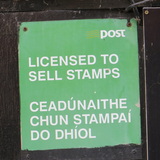He does mourn those who died in both World wars but has difficulty with other disputes and conflicts – particularly Northern Ireland. This brought to mind this monument in Kiltyclogher in Co.Leitrim which commemorates those who died in the Easter Rising, The War of Independence, The Civil War and also after that.
Those who survived the War of Independence substantially went on to be either the Pro-Treaty or Anti-Treaty side in the Civil War. Is it not reasonable, statistically, to assume that those who died in the War of Independence might also have been similarly divided?
After the end of the Civil War, some continued with the struggle for a 32-county Republic. The dead from the War of Independence and the Civil War did not have the luxury of taking a stand or position on the Treaty or end of an armed fight in May 1923. Is it reasonable to infer any such position upon them?
Does this plaque assume that had they survived the Easter Rising, The War of Independence and The Civil War, each of the men would have continued the fight which led to the deaths in 1938 and 1958? Does it assume as to the position that would have been taken by Sean MacDermott?
If one agreed with The War of Independence and The Treaty, but not the Civil War or the Republican Armed Struggle that continued thereafter, could one commemorate at this monument.
If one wished to commemorate the first nine men named on the monument but did not agree with the aims of the remaining five, could one do so at the monument or would one have to adopt a position similar to James McClean?



